Install or update the term checker for ASD-STE100
When you install the term checker, you automatically agree to the legal conditions.
During the installation, you will edit XML files. Use an XML editor or a text editor that has syntax highlighting (https://en.wikipedia.org/wiki/Syntax_highlighting).
Do these tasks:
- Make sure that you can use LanguageTool on your computer.
- Contact TechScribe for a free trial. After you receive a link to the term checker, do the installation.
Make sure that you can use LanguageTool on your computer
- In the command line, use
java -versionto make sure that Java 17 or a later version is on your computer. For example:T:\temp>java -version java version "25" 2025-09-16 LTS Java(TM) SE Runtime Environment (build 25+37-LTS-3491) Java HotSpot(TM) 64-Bit Server VM (build 25+37-LTS-3491, mixed mode, sharing) T:\temp> - If Java 17 or a later version is not on your computer, get Java 25 from https://www.oracle.com/uk/java/technologies/downloads/ and install it.
Note: "All other OpenJDK versions should also work, although there might be edge cases where the behavior of regex has changed" (https://forum.languagetool.org/t/java-versions-for-languagetool-standalone/9920). - Download and unzip https://internal1.languagetool.org/snapshots/LanguageTool-latest-snapshot.zip.
- At the command line, in the snapshot directory, type:
java -jar languagetool.jar
A message appears, and then LanguageTool starts.
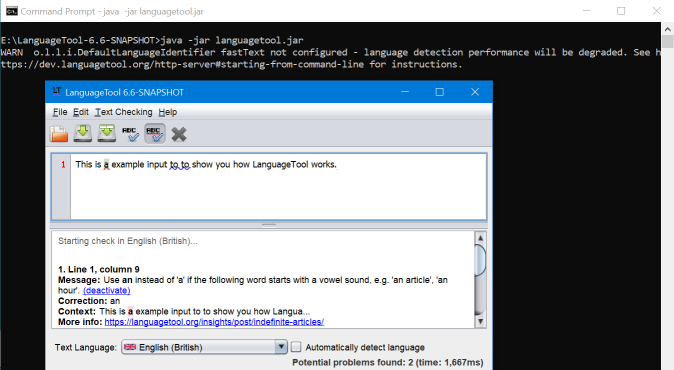
If LanguageTool does not start, get help from https://forum.languagetool.org/. TechScribe cannot help you. - Optional step. Install add-ons and plug-ins to integrate LanguageTool with other software. (You can do this task after you install the term checker, but it is better to make sure that the LanguageTool integrations operate correctly at this part of the installation process.)
- Optional step. Initially, LanguageTool uses the default language of your operating system for the text on the interface (GUI language). To see the default LanguageTool example in English, change the GUI language. The example shows Ukrainian to American English.
- Click the equivalent of Text Checking>Options.
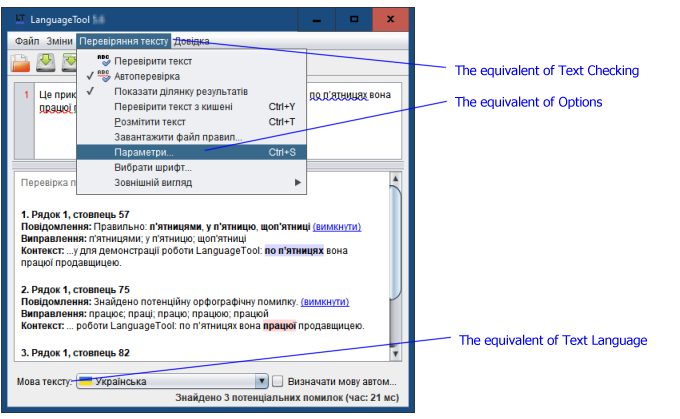
- Change the GUI language.
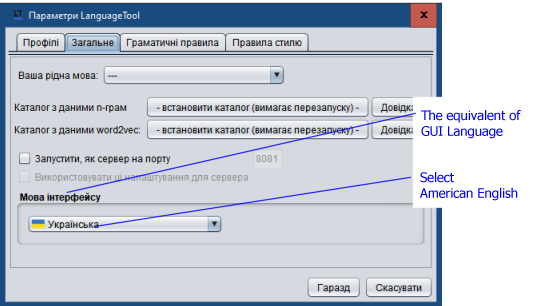
- Click the equivalent of Text Checking>Options.
- Close LanguageTool and do the installation.
Installation
Refer to The design of the term checker for ASD-STE100.
After you install the term checker, you will have this directory structure (most files and directories are not shown). In this example, ste-term-checker is the installation directory:
ste-term-checker
\data-files
disambiguation-projectterms.xml
grammar-projectterms.xml
\ste9-lt2025-09-23
languagetool.jar
\org\languagetool\resource\en\disambiguation.xml
\org\languagetool\rules\en\grammar.xml
The installation instructions refer to file name extensions (.jar, .xml, .zip) and paths. To prevent confusion, make sure that you can see the file name extensions and the path. For example, in Microsoft Windows:

The Java commands that are shown on this page are for Java 25. If you use earlier versions of Java, -Djava.xml.config.file=jaxp-strict.properties is not necessary. Refer to https://github.com/languagetool-org/languagetool/issues/11558.
If a problem occurs, refer to Troubleshooting.
1. Install the term checker
- In a convenient location, create this directory:
ste-term-checker. - In
ste-term-checker, create this directory:data-files. (You will use this directory when you download the templates for your project terms.) - In
ste-term-checker, download a compressed version of the term checker from the TechScribe website. The link is in the e-mail reply from TechScribe. - Decompress the file.
- Start the term checker. Use one of these methods:
- At the command line, in
ste9-lt2025-09-23, type:java -Djava.xml.config.file=jaxp-strict.properties -jar languagetool.jar - Microsoft Windows only: In
ste9-lt2025-09-23, double-clickTechScribeSTEchecker.bat:

Do not double-clicklanguagetool.jar. You will get a Java error message (https://github.com/languagetool-org/languagetool/issues/11161).
disambiguation-ste9-2025-10-10.xml,grammar-ste9-2025-10-10.xml,disambiguation-projectterms.xml, andgrammar-projectterms.xml
The total file size is approximately 4.5 megabytes. Thus, if your internet connection is slow, you must wait many seconds for LanguageTool to start. - At the command line, in
- If LanguageTool does not automatically check the text, click Check Text.
The screenshot shows what you will see.
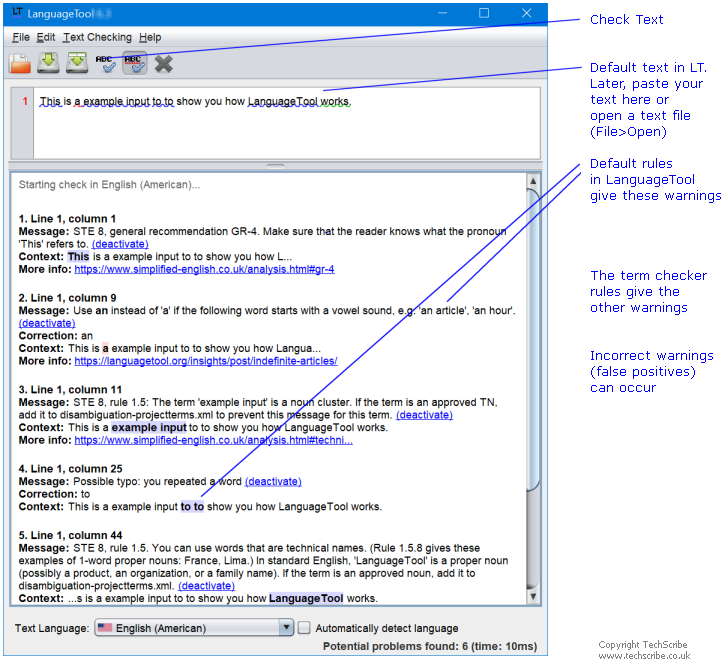
- In Text Language, select English (American) or English (British).
You can select other variants of English. Possibly, you will not get a correct analysis for locale-specific spelling rules. Refer to Use American English spelling (unless other official directives tell you differently) (rule 1.14). - Optional step if the GUI language is not English. You will see many STE errors, because the default text is not English. Paste the default LanguageTool text into the term checker to see the default LanguageTool analysis of English text:
This is a example input to to show you how LanguageTool works.
- LanguageTool has a small number of default rules that are in the LanguageTool Java code. Some default LanguageTool rules give unwanted error messages, as this example shows:

You can deactivate the rules that give unwanted error messages. - Optionally, to see the primary problems that the term checker identifies, use sample-text-for-ste-term-checker.txt.
- Close LanguageTool.
2. Optional step. Show error types in colour
It is possible to add an attribute to a rule to specify a Localization Quality Issue Type. The term checker uses the attribute values to add coloured backgrounds to the errors that it finds:

| Localization Quality Issue Type | Colour (hexadecimal value) | Meaning in the term checker | Applicable rules in ASD-STE100 |
|---|---|---|---|
| Addition | #FBDEBB | One or more words is a possible proper noun, or a singular determiner is used before a non-count noun. | The parts of 1.5 that are applicable to proper nouns (1.5.8, 1.5.10, 1.5.11, 1.5.15), 4.5 |
| Characters | #FF80FF | A character is a semicolon or a non-standard character. | 8.1 |
| Grammar | #C0FFC0 | The tense is not an approved tense. | 1.2, 3.2, 3.3, 3.4, 3.5 |
| Inconsistency | #E0E0C0 | A not-approved word is used with a different part of speech. | 1.1 |
| Legal | #D6D6D6 | Prototype rules. (The rules are not available to most users.) | None |
| Misspelling | #D0E0D0 | A word is approved, but the spelling is not correct. | 1.14 |
| Mistranslation | #FFFF80 | This error type is for semantics. One or more words are approved and the parts of speech are correct, but there is a possible semantic error. | 1.3, 1.5, 1.12.4, 2.1, 2.2, 3.2 ('be to' + infinitive only), 3.6, 3.7, 7.1, 8.1, 9.2, 9.3, GR-1, GR-2, GR-4, GR-6 |
| Non-conformance | #FFC0FF | A word contains a ligature or a sentence contains more than 20 alphanumeric tokens. | 5.1 |
| Omission | #C0C000 | A word is missing or a word is a contraction of an approved word. | 4.2, 4.5 |
| Other | #FF9800 | There is a disambiguation error or a character encoding error. | None |
| Register | #C0FFFF | A word is approved, but it is not used with its approved part of speech. | 1.2, 1.6, 1.7 |
| Terminology | #FFC0C0 | A term is not-approved or there is a possible hyphenation error. | 1.1, 1.4, 1.11, 3.1, 8.2 |
| Untranslated | #E0E0FF | A word is unknown in ASD-STE100. | 1.1 |
To show error types in colour
- Close LanguageTool.
- Open
.languagetool.cfgin a text editor. (In Windows,.languagetool.cfgis usually inC:\Users\Your Name.) - Add the line of code that follows:
Put the line of code into one of these locations:errorColors=addition:#FBDEBB, characters:#FF80FF, grammar:#C0FFC0, inconsistency:#E0E0C0, legal:#D6D6D6, misspelling:#D0E0D0, mistranslation:#FFFF80, non-conformance:#FFC0FF, omission:#C0C000, other:#FF9800, register:#C0FFFF, terminology:#FFC0C0, untranslated:#E0E0FF- If
.languagetool.cfgcontains a lineerrorColors=, replace the text. - If
.languagetool.cfgdoes not contain a lineerrorColors=, put the line of code at the end of the file (possibly, LanguageTool will change its position).
- If
- Close
.languagetool.cfg. - Double-click
languagetool.jar. Warnings about possible errors have a coloured background:

- Close LanguageTool.
3. Download the templates for your project terms
Although you can use the term checker if you do not do this procedure, you cannot add your technical terms to the term checker. Also, if TechScribe changes these templates when there is a new version of the term checker and if you use the files that are on the TechScribe website, errors can occur.
- Close LanguageTool.
- Download these files into the
data-filesdirectory: - Edit
ste9-lt2025-09-23\org\languagetool\resource\en\disambiguation.xml. In the line that containsProjectTermsDisambiguationRules, change the path to the path ofdisambiguation-projectterms.xmlon your computer.
For example, change:
<!ENTITY ProjectTermsDisambiguationRules SYSTEM "https://www.simplified-english.co.uk/disambiguation-projectterms.xml">
To:
<!ENTITY ProjectTermsDisambiguationRules SYSTEM "file:///D:/test/ste-term-checker/data-files/disambiguation-projectterms.xml"> - Edit
ste9-lt2025-09-23\org\languagetool\rules\en\grammar.xml. Change the line that containsProjectTermsGrammarRulesto the path ofgrammar-projectterms.xmlon your computer.
You can now customize the rules to include the technical nouns and the technical verbs that your organization uses.
4. Optional. Install the LanguageTool n-gram data
The term checker does not find all possible semantic errors or part-of-speech errors. For information about the errors that the term checker finds, refer to 'Rules'.
LanguageTool can use n-grams and a statistical method to find possible errors. The n-gram data is very large. Thus, the installation of the n-gram data is separate from the installation of the stand-alone version of LanguageTool. To install the n-gram data, refer to https://dev.languagetool.org/finding-errors-using-n-gram-data.
The screenshot shows examples of errors that the statistical method can find:
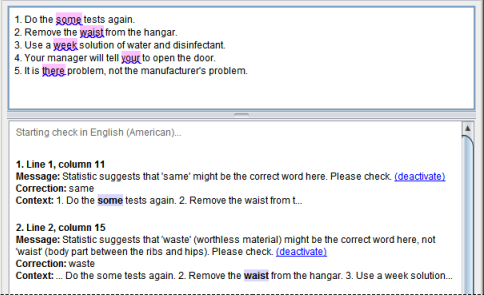
In the example sentences, all the words are approved in ASD-STE100, but they are used incorrectly:
- Do the some tests again: some is an approved adjective, but the correct adjective is same.
- Remove the waist from the hangar: waist is a technical noun (noun, rule 1.5.12), but the correct noun is waste.
- Use a week solution of water and disinfectant: week is a technical noun (noun, rule 1.5.4), and week solution is a multi-word noun (compare with oil filter). The correct word is weak (adjective).
- Your manager will tell your to open the door: your is an approved adjective, but the correct word is you (pronoun).
- It is there problem, not the manufacturer's problem: there is an approved pronoun, but the correct word is their (pronoun).
Update the term checker to use STE issue 9
When a new version of the term checker is available, TechScribe will tell you by e-mail and on the RSS feed.
After you install the term checker for STE issue 9, you can use it and you can use the term checker for STE issue 8.
To update the term checker to use STE issue 9
- Close LanguageTool.
- Change the name of the installation directory from
ste8-term-checkertoste-term-checker. - In
ste-term-checker, download a compressed version of the term checker from the TechScribe website. The link is in an e-mail from TechScribe. - Decompress the file to make the new directory
\ste9-lt2025-09-23and its contents.
You will have this directory structure (not all files and directories are shown):ste-term-checker \data-files disambiguation-projectterms.xml grammar-projectterms.xml \lt65-ste languagetool.jar \org\languagetool\resource\en\disambiguation.xml \org\languagetool\rules\en\grammar.xml \ste9-lt2025-09-23 languagetool.jar \org\languagetool\resource\en\disambiguation.xml \org\languagetool\rules\en\grammar.xml - To make sure that the installation is correct, in
\ste9-lt2025-09-23, start the term checker. Use one of these methods:- At the command line, in
ste9-lt2025-09-23, type:java -Djava.xml.config.file=jaxp-strict.properties -jar languagetool.jar - Microsoft Windows only: In
ste9-lt2025-09-23, double-clickTechScribeSTEchecker.bat:

Do not double-clicklanguagetool.jar. You will get a Java error message (https://github.com/languagetool-org/languagetool/issues/11161).
disambiguation-ste9-2025-10-10.xml,grammar-ste9-2025-10-10.xml,disambiguation-projectterms.xml, andgrammar-projectterms.xml
The total file size is approximately 4.5 megabytes. Thus, if your internet connection is slow, you must wait many seconds for LanguageTool to start. - At the command line, in
- Close LanguageTool.
- In
ste9-lt2025-09-23\org\languagetool\resource\en\, editdisambiguation.xml:- In the line that contains
ENTITY STE9DisambiguationRules, replace the default user/password with your user/password. - In the line that contains
ENTITY ProjectTermsDisambiguationRules, change the path to the path ofdisambiguation-projectterms.xmlon your computer.
For example, change:
<!ENTITY ProjectTermsDisambiguationRules SYSTEM "https://www.simplified-english.co.uk/disambiguation-projectterms.xml">
To:
<!ENTITY ProjectTermsDisambiguationRules SYSTEM "file:///D:/test/ste-term-checker/data-files/disambiguation-projectterms.xml">
- In the line that contains
- In
ste9-lt2025-09-23\org\languagetool\rules\en\, editgrammar.xml:- In the line that contains
ENTITY STE9GrammarRules, replace the default user/password with your user/password. - In the line that contains
ENTITY ProjectTermsGrammarRules, change the path to the path ofgrammar-projectterms.xmlon your computer.
- In the line that contains
- Optional step. Copy
PROJECT_APPROVED_MEANING_by_BYfrom the default grammar-projectterms.xml into your copy ofgrammar-projectterms.xml. - Start the term checker.
- If you do not want to use the term checker for STE issue 8, delete
lt65-ste.